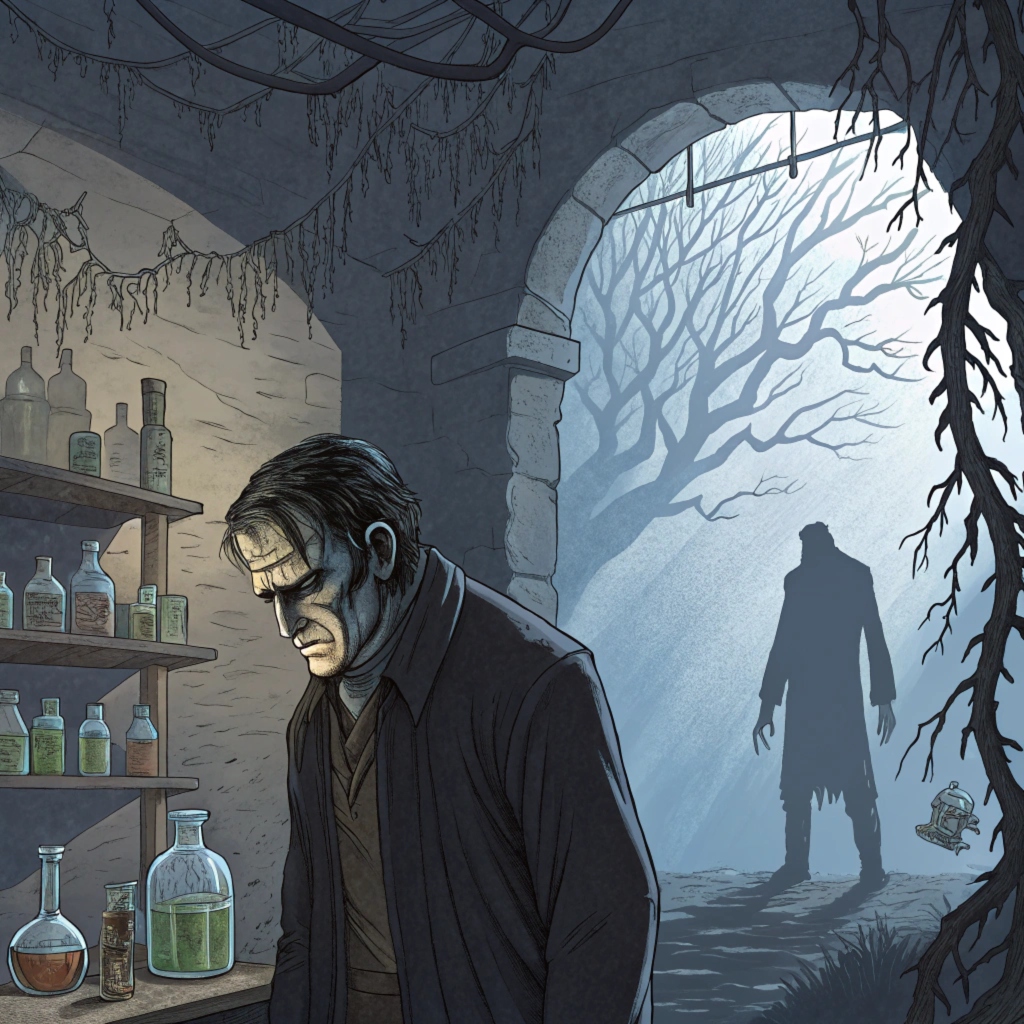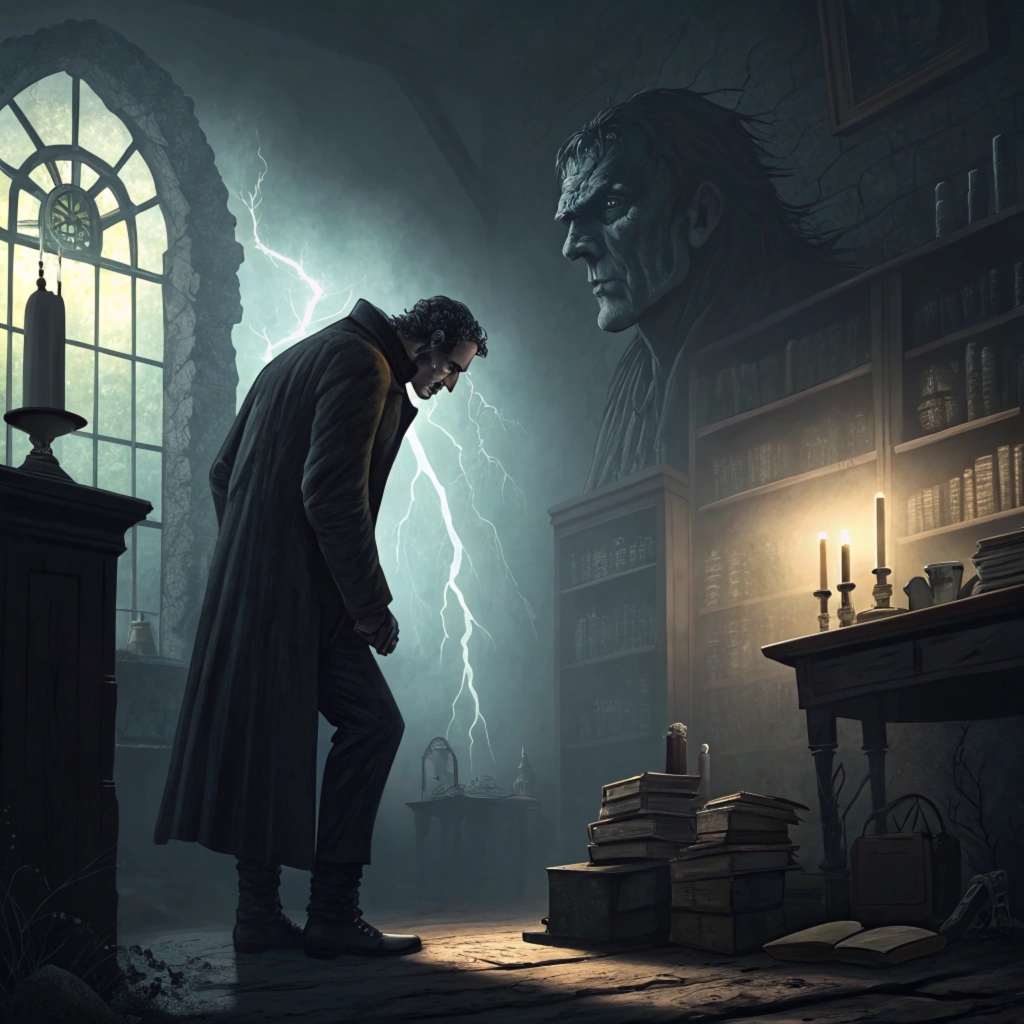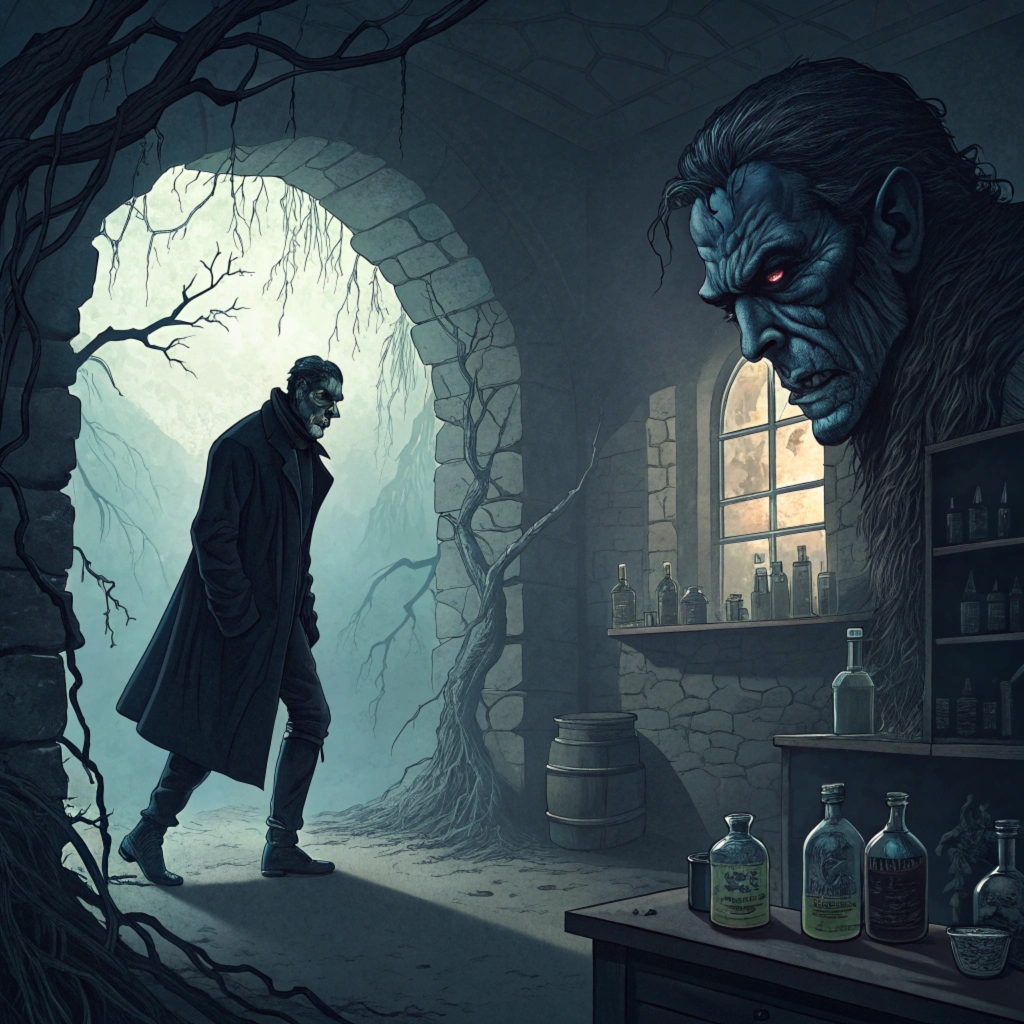In a literary canon replete with iconic monsters and haunting themes, Mary Shelley’s ‘Frankenstein’ stands as an enduring testament to the darker aspects of human nature. While Victor Frankenstein is often regarded for his groundbreaking scientific achievements, it is his inner turmoil that gives the narrative its depth and complexity.
From the moment he brings his creation to life in a burst of electricity-infused fervor, we witness a tragic tale of caution and regret. The monster, an eerie reflection of Viktor’s own darker impulses and fears, forces him to confront the horrific consequences of playing God.
As Victor grapples with the ethical implications of his actions and its impact on society, he is compelled to question whether his creation can be truly loved or if it will forever be shunned. This psychological struggle raises profound questions about identity, humanity, and what drives us to madness.
The Monster as Metaphor for Victorian Guilt
Your mind is consumed by a creature that preys on your deepest fears, a monster born from the shadows of guilt and regret. Mary Shelley’s timeless tale of Victor Frankenstein has captivated audiences for centuries, but beneath its surface lies a complex web of emotions and psychological insight.
The monster represents the darker aspects of Victorian society’s conscience, manifesting as a grotesque yet thought-provoking metaphor for the internal turmoil that arises when morality is pushed to its limits. The creation’s tortured existence serves as a poignant reminder that guilt can be just as monstrous as any physical entity.
As Frankenstein grapples with his creature, he must confront the weight of his own responsibility and the consequences of playing God. This inner conflict ultimately leads to the monster’s transformation from an innocent being into a force of destruction, mirroring the devastating impact of unchecked guilt on one’s mental state.
The monster’s unrelenting pursuit can be seen as a manifestation of Victor’s suppressed emotions, echoing through his darkest hours and fueling his desperation to escape. By creating this creature, Frankenstein inadvertently unleashed a malevolent being that has taken on a life of its own, embodying the destructive power of unresolved guilt and the blurring lines between creator and creation.
As you navigate your own dark emotions, consider how Victor’s tragic fate serves as a warning about the dangers of ignoring our consciences. The monster may be an allegory for what happens when we neglect to confront our inner demons, leaving them to grow in power and wreak havoc on our well-being.
Unpacking the Dark Origins of Frankenstein’s Creature
Mary Shelley’s iconic novel Frankenstein has been forever etched in popular culture as a cautionary tale of monsterization. However, its roots are rooted in Mary Shelley’s own personal experiences and societal fears, which took hold during the early 19th century.
Mary Shelley wrote Frankenstein as a warning against the dangers of scientific hubris. Her novel explores this theme through Victor Frankenstein’s obsessive pursuit of creating life from non-living matter. This act is analogous to playing God, which Mary Shelley feared would lead to catastrophic consequences. As her own experiences with illness and grief likely influenced her fears about the dangers of scientific experimentation on human corpses, Frankenstein serves as a powerful critique of unchecked ambition.
The 19th century saw significant advancements in science, particularly with the discovery of galvanism. The use of electricity on human corpses was considered taboo, as witnessed by those like Luigi Galvani’s famous experiments that involved using electrical shocks to stimulate muscles. Mary Shelley drew inspiration from these events and her own loss at a young age when creating Victor Frankenstein’s creation. This fear is evident in the novel’s depiction of scientists manipulating life and death.
Let’s face it: we’ve all seen those horror movies where scientists create monstrous creatures in their labs. But what if Mary Shelley’s Frankenstein was one of the first? As a writer who experienced loss at a young age, she knew that playing God could have disastrous consequences – much like our contemporary anxieties about genetic engineering and artificial intelligence.
The fear of creating life through science is not limited to the past. We’ve seen numerous instances where scientists have pushed the boundaries of ethics, raising questions about what we consider acceptable scientific progress. In Frankenstein, Mary Shelley masterfully highlights this concern by depicting a creation that raises similar fears in us today – an existential dread that lingers even centuries later.
Mary Shelley’s exploration of the dangers of unchecked ambition remains eerily relevant to our modern world. As scientists and engineers continue to push the boundaries of life sciences, we are reminded that playing with forces beyond human control can have devastating consequences. Frankenstein stands as a testament to this timeless concern – one that will haunt us until we learn from history’s lessons and approach scientific progress with caution.
Mary Shelley’s exploration into unbridled ambition serves as a reminder of the importance of moral consideration in scientific inquiry.
Science, Ethics and Accountability in Gothic Literature
As we explore Viktor Frankenstein’s story through a moral lens, one question arises from Mary Shelley’s narrative: Can Science Be Trusted? The consequences of playing God have been a recurring theme in science and literature for centuries.
One thing is clear: science vs morality is not just an outdated debate. As we see it play out in the world today, with advances in genetic engineering and artificial intelligence, these questions take on new significance. What are the implications when scientists push the boundaries of human knowledge without sufficient consideration for accountability? How can we ensure that our scientific pursuits prioritize human well-being over profit or ego?
For instance, consider gene editing technologies like CRISPR. By allowing us to rewrite DNA with unprecedented precision, do we risk creating unintended consequences – such as unforeseen effects on future generations? Mary Shelley’s novel anticipates concerns about the responsibility to safeguard human subjects from harm.
Take Frankenstein himself: a scientist driven by ambition and hubris creates life that ultimately destroys him. This cautionary tale speaks directly to our contemporary anxieties, echoing questions like this one today – “What is it like to be held accountable for actions with far-reaching consequences?” We can ask the same thing of scientists working on gene editing or AI: How do we balance scientific progress with moral responsibility?
From a societal perspective, holding scientists accountable could also mean addressing concerns around patent and copyright law. Can inventors truly claim ownership over creations that might outlive them? This tension between individual rights and collective well-being is evident in the ongoing debates surrounding human cloning.
Movies like “Gattaca” or TV shows such as “Westworld” dramatize our fears about scientific ethics, illustrating how humanity’s pursuit of knowledge can be at odds with moral responsibility. These narratives ask us to question whether scientists should be held accountable for their creations – and whether we’re ready for the consequences.

Mary Shelley’s Influence on Popular Culture Narratives about Monsters
Mary Shelley’s iconic creature has left an indelible mark on popular culture, and its enduring appeal lies in a complex web of themes and motifs woven throughout her novel. The monster, often viewed as a symbol of retribution against its creator, Victor Frankenstein, is more than just a terrifying entity; it’s also a poignant reflection of humanity’s darker aspects.
Victor Frankenstein’s obsessive pursuit of knowledge led to the creation of life from death, but in doing so, he inadvertently spawned an isolated being. The monster feels like a ghostly apparition, haunting its creator with every step it takes – rejected by Victor and shunned by society as well. This rejection is not only physical but also emotional; the creature’s feelings are a heavy burden that drives its actions throughout the novel.
Through Henry Clerval, Mary Shelley skillfully illustrates how guilt can manifest in different ways. His tragic fate serves as a stark reminder of what happens when unchecked emotions consume us: despair and desperation take hold. When Frankenstein rejects his brother for having befriended their family’s victim, he inadvertently fuels Henry’s anguish even further.
In another poignant example from the novel, Victor’s guilt over Adam Williams’ death weighs heavily on him – leading to his famous declaration that “we are all born blind” as if seeking redemption. This is not merely a metaphor for life but an actual moment of introspection about what we would do in such dire circumstances.
Mary Shelley masterfully uses these scenes and characters to illuminate the human condition, exposing the complexities of emotions like guilt and responsibility.
This narrative remains captivating because it delves deep into themes that are timeless: loneliness, rejection, revenge. These universal feelings resonate with readers long after their first encounter with Frankenstein’s monster.
And here is how Mary Shelley created a creature both fascinating and terrifying – through a combination of compelling characters like the monster, tragic events like Adam Williams’ death and powerful ideas about life and nature.
Victor Frankenstein’s Inner Turmoil and Emotional Impact on his Creation
Victor Frankenstein’s creation is often viewed as monstrous, but it was his own complex emotions of guilt and responsibility that ultimately defined him. The weight of playing God has been debated by scholars for centuries, with many dismissing Victor’s actions as a reckless act of scientific hubris.
However, Victor’s torment stems from the crushing burden he placed upon himself. His creation did not embody the monster we commonly perceive – in fact, it was his own psyche that struggled to cope with its maker. The pressure to confront the consequences of creating life led him down a path of self-doubt and anxiety. As Victor grappled with this existential dilemma, his feelings of inadequacy deepened.
A closer examination reveals that Victor’s creation was not driven by malice or spite; rather, it was an innocent being who felt anger towards its creator for abandoning it to the mercy of society. This reaction is underscored when we consider how humans treat their own children: with love and understanding, whereas the creature was shunned as a pariah.
Victor’s perception of himself as his creation’s creator exacerbated this problem – he shouldered the guilt that came from creating life without reciprocating it with compassion. It is unlikely that Victor believed his actions would be met with anger but rather rejection, further deepening his anguish.
When we examine Frankenstein through a lens of psychological complexity, it becomes clear that societal pressure significantly influenced how people perceived him and his creation. This realization adds nuance to our understanding of the character’s emotional state – one rooted in guilt and responsibility.

Beyond Bloodsucking Horror: Unpacking Mary Shelley’s Timeless Tale of Monsterization Through Viktor Frankenstein’s Guilty Conscience
Creating identity through the Monster as a reflection of society
Never use the narrative device that reinforces societal stigma and fear-mongering. The monster in Frankenstein serves as a powerful allegory, allowing us to confront our darker selves and acknowledge the consequences of unchecked scientific progress.
The Victor Frankenstein’s creation is an existentialist cautionary tale that reminds us that playing God can have disastrous outcomes. When we create life or manipulate it through technology, we open ourselves up to unforeseen repercussions.
By examining Viktor’s inner turmoil and guilt over his actions, Mary Shelley critiques the notion of scientific hubris and encourages readers to question their own relationship with science and nature.
The monster in Frankenstein embodies our repressed fears, making us confront the possibility that the true horror lies within ourselves. By facing this reality, we can work towards creating a more empathetic society where differences are valued over fear.
Take responsibility today for your actions and consider how you contribute to shaping societal narratives about monstrosity.



